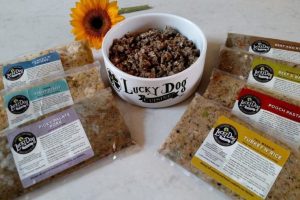 Photo credit www.luckydogcuisine.com
What a veterinarian chooses to feed of his or her pets is a topic that has innumerable answers. Each veterinary practitioner has a unique perspective on what is perceived to be the most-appropriate food for one’s own pets and patients.
Photo credit www.luckydogcuisine.com
What a veterinarian chooses to feed of his or her pets is a topic that has innumerable answers. Each veterinary practitioner has a unique perspective on what is perceived to be the most-appropriate food for one’s own pets and patients.I really feel that the way I approach my own nutrition comes across in my veterinary practice. I've always been an advocate for whole food-diets for myself and strive to minimize processed foods entering my body. As I am 45 years old (as of 8/18), have minimal health concerns, and have been able to maintain a slim body condition my whole life I have to at least in part attribute the ongoing ability for me to feel good and be healthy to my diet and lifestyle habits.
My attitude about the best foods to feed pets has dramatically changed over the years. When I first graduated from the University of Pennsylvania School of Veterinary Medicine in 1999 I was under the impression that our canine and feline companions should never eat human foods and should only eat commercially-available, species-specific, foods and treats.
Over my 20 years of veterinary practice I have observed so many dogs and cats suffering from otherwise reversible and potentially-fatal health problems (obesity, arthritis, diabetes, mobility problems, etc.) as a result of primarily eating such pet foods and treats, generally in volumes that exceed their daily caloric needs.
When I started Chinese medicine training with the International Veterinary Acupuncture Society (IVAS) in 2005 my eyes were open to a different perspective on feeding and since then have gravitated towards the recommendation for my patients to eat diets that are human-grade, whole-food, cooked, and either commercially-available or home-prepared.
For the first few years of my dog Cardiff’s life I fed a human-grade, home-prepared, cooked, whole-food diet inspired by the recipes in Dr. Pitcairn’s book the Complete Guide to Natural Health For Dogs & Cats. Cardiff thrived on these diets, but I found when I moved from Washington to Los Angeles in 2006 my professional responsibilities created time constraints that prompted me to seek a more-convenient feeding style. At that time, there were not any options available for owners to buy a human-grade, commercially-available, cooked, whole-food diet of which I was aware. So, I starting feeding Cardiff a combination of feed-grade, commercially-available, “seemingly-high-quality”, raw-coated, dry food (kibble) containing whole-food ingredients and commercially-available, frozen, raw meat diets. Within 6 months of making this transition he incurred his first episode of immune-mediated hemolytic anemia (IMHA).
Although I don't feel Cardiff’s IMHA was directly caused by his diet, there were some factors that could have contributed (protein sources that were considered warming/heat-inducing according to Chinese medicine food energy theory, heating/dry format, feed-grade ingredients potentially harboring toxins, etc.). I had to change his feeding strategy because a significant portion of the treatment for an immune-mediated diseases like IMHA is immunosuppressive drug therapy. As commercially-available diets containing raw-meat components are at higher risk for contamination with pathogenic bacteria like Salmonella, Listeria, E. coli, and others (see U.S Food & Drug Administration Recalls and Withdrawals), I could not put Cardiff at risk for a significant setback in his treatment process should one of those organisms enter his body via his food.
I started feeding him a cooked, commercially-available, canned, veterinary-prescription, easily-digestible diet on which his digestive tract did well (formed poops, no vomiting, etc.) and he made a routine recovery to an otherwise-normal state. I then was introduced to Lucky Dog Cuisine and found myself drawn to its human-grade, cooked, whole-food qualities along with it being commercially-available and shipped right to my home. Additionally, there were protein sources that are considered cooling (turkey and fish) and neutral (beef and pork) that readily fit into my Chinese medicine feeding strategy that I feel contributed to Cardiff being in a non-hemolytic state.
Over the years I’ve seen many of my patients thrive while eating Lucky Dog Cuisine. When appropriate quantities of Lucky Dog Cuisine are fed (and excessive calories from treats or other foods are not consumed), my patients maintain a slim body condition. Digestive, dermatologic (skin), endocrine (glandular), immune-system, and other abnormalities are generally improved or resolved. My clients are happy to see such a healthful response and are enthused that their dogs get to eat ingredients that are the same quality (i.e. human-grade) as the foods that enter their own mouths.
This is why Lucky Dog Cuisine is my top dietary recommendation for my canine patients. Learn more via this article for Reader’s Digest The Dog Food Brands Veterinarians Feed Their Own Pets via Reader's Digest.
 Dr. Patrick Mahaney
Dr. Patrick Mahaney
Please leave your constructive perspective in the below Comments section and communicate with me and follow my adventures in veterinary medicine and life via Instagram (@PatrickMahaney), Twitter (@PatrickMahaney), and Facebook (Patrick Mahaney: Veterinarian Acupuncture Pain Management for Your Pets).
Copyright of this article (2018) is owned by Dr. Patrick Mahaney, Veterinarian, Certified Veterinary Acupuncturist and Certified Veterinary Journalist. Republishing any portion of this article must first be authorized by Dr. Patrick Mahaney. Requests for republishing must be approved by Dr. Patrick Mahaney and received in written format.
